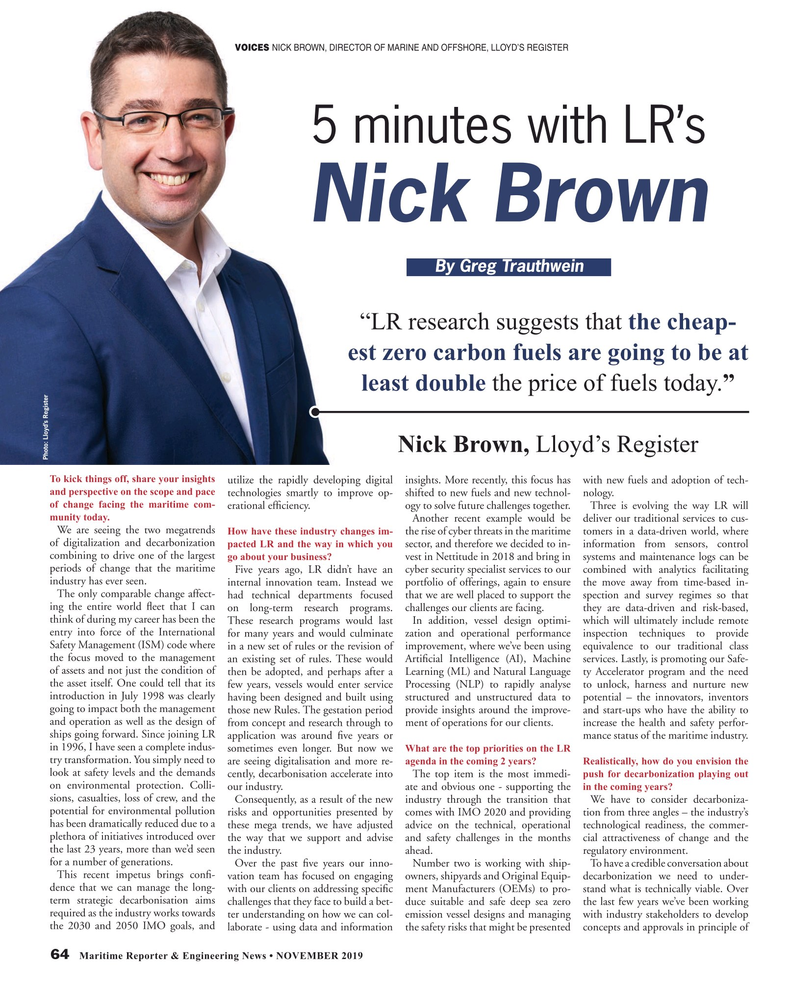
Page 64: of Maritime Reporter Magazine (November 2019)
Workboat Edition
Read this page in Pdf, Flash or Html5 edition of November 2019 Maritime Reporter Magazine
VOICES NICK BROWN, DIRECTOR OF MARINE AND OFFSHORE, LLOYD’S REGISTER 5 minutes with LR’s
Nick Brown
By Greg Trauthwein “LR research suggests that the cheap- est zero carbon fuels are going to be at least double the price of fuels today.”
Nick Brown, Lloyd’s Register
Photo: Lloyd’s Register
To kick things off, share your insights utilize the rapidly developing digital insights. More recently, this focus has with new fuels and adoption of tech- and perspective on the scope and pace technologies smartly to improve op- shifted to new fuels and new technol- nology. of change facing the maritime com- erational ef? ciency. ogy to solve future challenges together. Three is evolving the way LR will munity today.
Another recent example would be deliver our traditional services to cus-
We are seeing the two megatrends the rise of cyber threats in the maritime tomers in a data-driven world, where
How have these industry changes im- of digitalization and decarbonization sector, and therefore we decided to in- information from sensors, control pacted LR and the way in which you combining to drive one of the largest vest in Nettitude in 2018 and bring in systems and maintenance logs can be go about your business? periods of change that the maritime
Five years ago, LR didn’t have an cyber security specialist services to our combined with analytics facilitating industry has ever seen.
internal innovation team. Instead we portfolio of offerings, again to ensure the move away from time-based in-
The only comparable change affect- had technical departments focused that we are well placed to support the spection and survey regimes so that ing the entire world ? eet that I can on long-term research programs. challenges our clients are facing. they are data-driven and risk-based, think of during my career has been the These research programs would last In addition, vessel design optimi- which will ultimately include remote entry into force of the International for many years and would culminate zation and operational performance inspection techniques to provide
Safety Management (ISM) code where in a new set of rules or the revision of improvement, where we’ve been using equivalence to our traditional class the focus moved to the management an existing set of rules. These would Arti? cial Intelligence (AI), Machine services. Lastly, is promoting our Safe- of assets and not just the condition of then be adopted, and perhaps after a Learning (ML) and Natural Language ty Accelerator program and the need the asset itself. One could tell that its few years, vessels would enter service Processing (NLP) to rapidly analyse to unlock, harness and nurture new introduction in July 1998 was clearly having been designed and built using structured and unstructured data to potential – the innovators, inventors going to impact both the management those new Rules. The gestation period provide insights around the improve- and start-ups who have the ability to and operation as well as the design of from concept and research through to ment of operations for our clients. increase the health and safety perfor- ships going forward. Since joining LR application was around ? ve years or mance status of the maritime industry.
in 1996, I have seen a complete indus- sometimes even longer. But now we
What are the top priorities on the LR try transformation. You simply need to are seeing digitalisation and more re- agenda in the coming 2 years? Realistically, how do you envision the look at safety levels and the demands cently, decarbonisation accelerate into The top item is the most immedi- push for decarbonization playing out on environmental protection. Colli- our industry. ate and obvious one - supporting the in the coming years?
sions, casualties, loss of crew, and the
Consequently, as a result of the new industry through the transition that We have to consider decarboniza- potential for environmental pollution risks and opportunities presented by comes with IMO 2020 and providing tion from three angles – the industry’s has been dramatically reduced due to a these mega trends, we have adjusted advice on the technical, operational technological readiness, the commer- plethora of initiatives introduced over the way that we support and advise and safety challenges in the months cial attractiveness of change and the the last 23 years, more than we’d seen the industry. ahead. regulatory environment.
for a number of generations.
Over the past ? ve years our inno- Number two is working with ship- To have a credible conversation about
This recent impetus brings con? - vation team has focused on engaging owners, shipyards and Original Equip- decarbonization we need to under- dence that we can manage the long- with our clients on addressing speci? c ment Manufacturers (OEMs) to pro- stand what is technically viable. Over term strategic decarbonisation aims challenges that they face to build a bet- duce suitable and safe deep sea zero the last few years we’ve been working required as the industry works towards ter understanding on how we can col- emission vessel designs and managing with industry stakeholders to develop the 2030 and 2050 IMO goals, and laborate - using data and information the safety risks that might be presented concepts and approvals in principle of 64 Maritime Reporter & Engineering News • NOVEMBER 2019
MR #11 (58-65).indd 64 11/4/2019 10:15:11 AM

 63
63

 65
65
